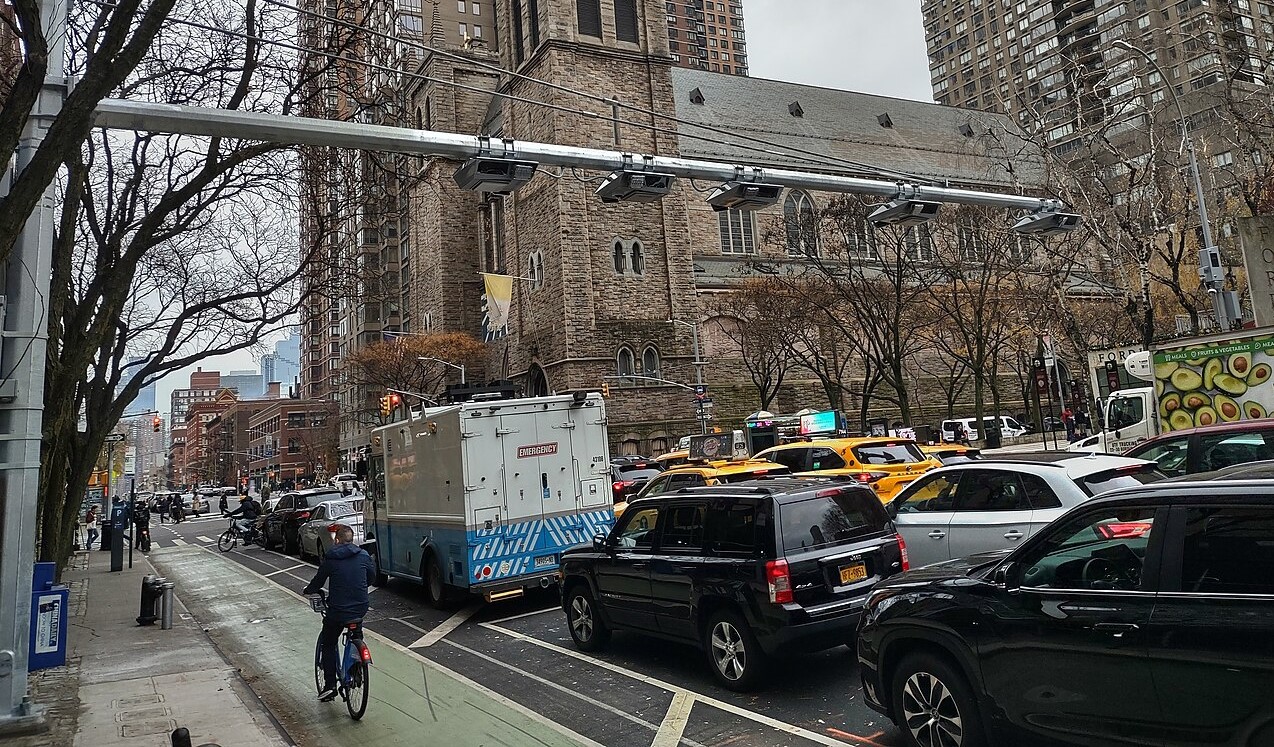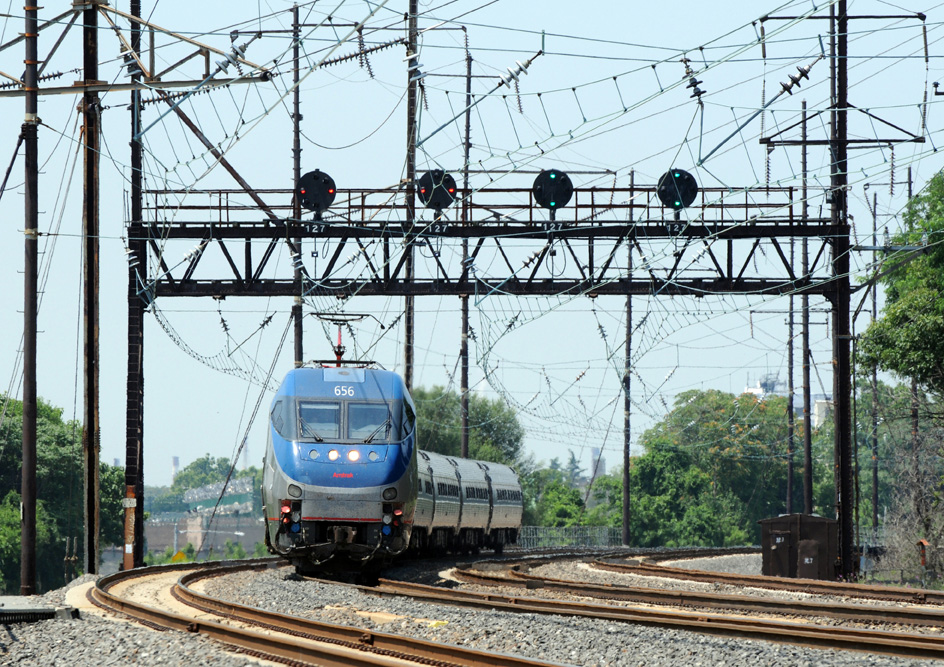European countries are making strides toward saving their most vulnerable road users and the climate — even as the U.S. Congress plods toward an infrastructure deal that will funnel billions into new roads for drivers.
If you haven't heard, a series of complex negotiations in Washington are on track to set the U.S.'s national transportation priorities for the next decade (and potentially put thousands of electric cars on the road for even longer). European leaders, meanwhile, have been pushing a set of far more progressive measures to help residents who walk, bike or use mobility assistive devices get around.
Here are five stories that we hope will inspire U.S. lawmakers to get their priorities straight — before it's too late.
The U.K. puts peds first...
American lawmakers are pushing to retain a federal law that allows states to set regressive safety "targets" — allowing them to collect federal money while doing nothing to reduce road deaths (although an amendment could fix that, if it gets enough support).
In Britain, however, legislators are doing the opposite, by building a roadway hierarchy that puts walkers and bikers first.
The United Kingdom Department of Transport recently announced that it will revise the next edition of the Highway Code — a sort of master document of national traffic safety laws and road design guidelines — to give the default right of way to the most vulnerable road users in almost all crosswalks, sidewalks and other shared street spaces. Best of all, the department will back up the changes with £338 million ($469 million) to "boost cycling and walking [and] sustain the increase in active travel during the pandemic," including through new infrastructure.
UK - "The new Highway Code, subject to approval from parliament when MPs return from summer recess, will introduce strengthened pedestrian priority on sidewalks and when they are crossing or waiting to cross a road." https://t.co/i6H5fyPrxZ
— IFPedestrians (@IFPedestrians) July 31, 2021
For comparison, the United States's Transportation Alternatives program, which funds biking and walking improvements, would get a long-sought $486 million funding boost under the Bipartisan Infrastructure Bill — but that would be spread across a country with five times the U.K.'s population and 40 times the land mass.
"The Highway Code currently treats children walking to school and lorry [freight truck] drivers as if they are equally responsible for their own or other people's safety," safe streets advocate Stephen Edwards told the BBC. "These changes will redress that balance."
Wish we could say the same of the former Colonies.
...and London proves Low Traffic Neighborhoods save lives
One local program that fostered the U.K.'s big shift was London's Low Traffic Neighborhoods (or Livable Neighbourhoods, in Brit-speak), which proliferated across the Big Smoke during the pandemic.
When the city temporarily closed off certain streets to through traffic from drivers who don't live and work in those areas, huge parts of London were opened up to people on foot, bike, wheelchair and more. According to a study released this week, the effort more than halved roadway deaths on the streets that got the revolutionary low-car treatment compared to roads that didn't.
What is a Liveable Neighbourhood? pic.twitter.com/UweUxzD0H3
— Oxfordshire Liveable Streets (@OxLivSts) June 21, 2020
That's just the latest study that shows the benefits of the popular scheme, which Greenpeace notes helps low-income communities and may help erase disparities in pedestrian deaths among residents of color while also getting more people on bikes.
The U.S. infrastructure bill provides no federal money for cities to explore similar pilots.
Barcelona commits to giving driving lanes back to people
Barcelona's famous low-traffic neighborhoods program — known internationally as "Superblocks" — has been revolutionizing life in the city since 2016. And much like London, Barcelona has expedited those changes during the pandemic, even returning several erstwhile driving lanes to pedestrians.
"Originally described as provisional by city authorities, the changes are still in place a year later despite opposition from some business groups," Reuters journalist Joan Faus reported this week.
🚶🏻♀️Carrers pensats per al vianant i on el verd esclata amb més arbres i més frondosos.
— BCN EcologiaUrbana (@BCN_Ecologia) August 5, 2021
Així serà el carrer del segle XXI que s'implantarà als nous eixos verds de la #SuperillaBarcelona començant pels de Consell de Cent, Girona, Rocafort i Comte Borrell.🌳https://t.co/BMfL98j756 pic.twitter.com/3jQtx0rbhx
Rough translation: "Streets designed for pedestrians are bursting with green, thanks to more trees and shrubs. These kinds of 21st century streets are becoming the newest green axes of the #BarcelonaSuperblock program, starting with the Consell de Cent, Girona, Rocafort and Comte Borrell [thoroughfares.]
Barcelona's transformation is being driven, in part, by a 2019 European Commission report that found that Spain's largest cities regularly exceeded legal limits on greenhouse-gas emissions. The most recent round of street design changes are widely credited with bringing Barcelona below the limits for the first time.
The U.S., meanwhile, is undermining the historic climate measures in its infrastructure bill by subsidizing new highways.
Germany bets big on cargo trikes
Europe's low-car neighborhoods aren't popular with everyone. Local business owners sometimes object, especially if they think the schemes make package deliveries harder.
Fortunately, a study this week found that electric cargo bikes deliver parcels 60 percent faster than large vans in city centers, especially when those city centers have dedicated cycling infrastructure that keeps the vehicles out of congested driving lanes. The study pointed out that up to 51 percent of all freight journeys in cities could be completed via the bikes.
"The bicycle is the most efficient machine ever created...a triangle-framed bike can easily carry 10x its own weight—capacity no automobile, airplane or bridge can match.” —Bill Strickland.
— Taras Grescoe 🚇 @straphanger@urbanists.social (@grescoe) August 5, 2021
Cargobikes can carry even more…
pic.twitter.com/VtF0D68VzK
That's great news for Germany, whose largest postal carrier also announced this week that it will invest in 5,000 more e-tricycles by 2025.
Meanwhile, the flawed (but, advocates say, still necessary) U.S. infrastructure bill may be held hostage unless the Senate also passes a budget resolution that reportedly contains billions in consumer incentives for electric cars but nothing in consumer incentives for electric bikes. It's not clear whether commercial freight trucks will be eligible for the incentives, but we do know delivery e-bikes will not receive federal subsidies.
And the Netherlands got a gorgeous rainbow bike lane
If you need us, we'll just be crying into the text of the House's visionary INVEST Act...after we pull it from the trash where the Senate threw it.
Last month, Utrecht cut the ribbon on the world’s longest rainbow cycle track.
— Melissa & Chris Bruntlett (@modacitylife) July 26, 2021
Dreamed up by a student, the five meter wide, 570 meter long path runs through the heart of the university campus as a symbol for diversity and inclusion.
Join us for a ride along its entire length. pic.twitter.com/cM7M8VNExb






